In everyday life, a small table fully meets the needs of a family of 3-4 people. Such a table is successfully used both as a kitchen, and as a dining. The situation changes dramatically when guests appear. Many people have a desire to make a sliding table with their own hands.
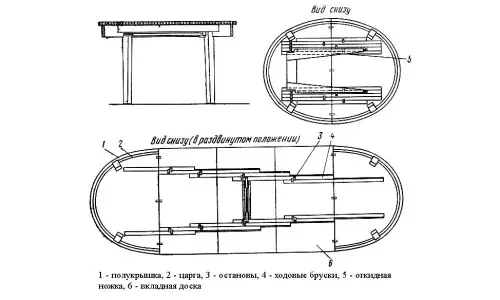
Sliding table circuit.
Any table is not a very simple design, which should withstand significant loads and frequent movements around the apartment. Despite certain difficulties, make the sliding table with their own hands under the power of anyone who is familiar with the joinery. Constructions of sliding and folding tables set. It is only necessary to actually appreciate which one you can do.
Step-by-step instructions: the basics of design
Any table consists of a tabletop, legs and fasteners. Sliding (folding) structures additionally contain removable or movable inserts of the countertops and the sliding mechanism. In the form of the tabletop can be round (in the proportion of state - oval) or square (rectangular).
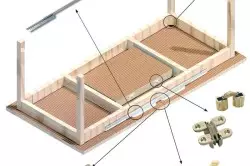
Scheme of attachment of the guide sliding table.
The basic requirements that are presented to the design are the strength of the table top and the reliability of the feet of the legs, which should allow you to withstand loads (including drums) and be resistant when used during cooking or dinner. In addition, the surface must be comfortable and practical.
The size of the table is determined mainly by room dimensions and the number of guests that can sit at the same time. The height of the dining table is usually 73 cm. The dimensions in the proportion can be calculated on the basis of the condition that the optimal distance per person at the table is 60-70 cm.
Choosing basic materials
If it is decided to make the table with your own hands, you should decide on the material for the main elements. Aesthetic impression of the design of the table mainly provides a countertop. In addition, moisture, fat and other active substances applied during cooking; Increased temperature from hot dishes; Significant mechanical loads can be applied. Wooden countertops are quite reliable, environmentally friendly, practical and aesthetic, but at the same time roads and complex in the manufacture.
The greatest use as countertops found wood pine, oak and walnut. When using wood, it should be well dried and treated with moisture-proof compositions. If a natural tree is applied to the surface, then it must be polished periodically, as well as sheet or wax.
Article on the topic: Pouring of a warm floor: Step-by-step instructions
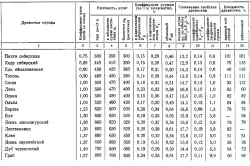
Characteristics of materials for the manufacture of a table.
Simple, cheap, but a fairly reliable countertop is obtained from laminated wood-chip plate with a thickness of at least 20 mm. The ends of the plates are rounded and coated with protective material, for example, silicone or polyvinyl chloride film. Such plates can be additionally covered with plastic. The latter disadvantage of such a material is swelling when moisture in the thickness of the material. For other indicators, this material is quite capable of competing with wood.
The feet of the table can be made independently, and you can buy ready. The most common option is the legs of a wooden bar. The minimum dimensions of the bar are 40x40 mm. For large tables, the larger bar should be used. So, for the table length (in the suspended state) about 2 m is recommended for a timing of 85x85 mm. The legs can be square, round or carved depending on the desire and capabilities of the manufacturer.
In addition to wooden legs, metal is used. For example, you can purchase ready-made metal legs in the form of a pipe with a diameter of 70-90 mm. You can make steel or aluminum legs from the pipe and various profiles.
Sliding table design
One of the most simple designs of the sliding table is based on an increase in size due to the sort of surface and laying additional elements. The main countertop consists of two parts that are not fastened with legs and have the possibility of longitudinal movement in opposite sides.
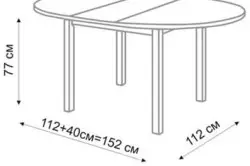
Drawing of the kitchen sliding table.
The sliding structure consists of the following main parts: the base; The main countertop consisting of two identical parts; Full-point guides; Additional panels. The base is made in the form of a frame connecting the legs with each other with the help of jumpers (colangu), and the top panel, resembling the tabletop, but fixed on the legs.
Each of the parts of the main countertop consists of directly surface and fixed on it three sidewalls. The extension mechanism is recommended to be made from standard dial guides for retractable boxes. It is necessary to purchase two sets of the guide length of at least 30 cm. Additional elements of the table top are made similarly to the main surface and have a length equal to the width of the table top, and their width is determined by the length of the extension. The number of elements can be from 1 to 3 at the discretion of the manufacturer.
The principle of the construction of the design is very simple: both parts of the main table tops are mixed in the guides fixed on the basis of the table, until it stops. At the same time, the table top slides on the surface of the base. In the resulting space between two parts, additional elements are installed, which together with the main parts create a form of a solid table top.
Article on the topic: Use on loggia and balcony panoramic windows
Production of the base
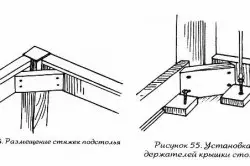
Table cover setup diagram.
The main function of the base of the table is a reliable connection of the table legs with each other and ensuring support for installation of the table top. The binding of wooden legs into a single frame is made with the help of wooden jumpers - Cang. Canggi is made of plywood or boards 10-12 cm wide and a thickness of 18-20 mm. The length of the colang is determined by the selected table size in the inhabitual state.
To secure the colang, in the upper part of the legs on two adjacent sides, the grooves are made of the size corresponding to the cross section of the collet, a depth of 20 mm. In the grooves are fixed by the ends of the colang. The connection site is sick and strengthened with screws. To strengthen the connection of the legs in heavy tables, it is recommended to install wooden slats in the connection locations.
From above the frame is fixed by a sheet of plywood with a thickness of 10-12 mm. The size of the sheet is determined by the dimensions of the frame. Sheet is fixed with screws. In the final form, the base is a table with a draft countertop. The upper plywood sheet is not a mandatory element, as the design will be operational and without it.
Making the main table top
First, it takes out the cutting and cutting the two parts of the table top of the selected sizes. If necessary, the surface and sealing of the ends are made. On the inner end (which is combined with the end of the second part) of each of the parts of the table top two holes are drilled to enter them the removable elements in them. The diameter of the opening is 8-10 mm.
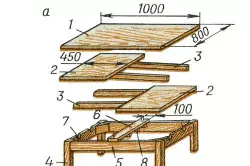
Assembling and disassembling sliding table.
A P-shaped side of the sidewall is made, which is a strip of a chipboard or a $ 100-120 mm width and a thickness of 18-20 mm. The sidewall length corresponds to the size of the base of the table, measured by the legs. Corners of the box are strengthened with an aluminum corner from the inside.
On the inside of the side parts of the housing, narrow (reverse) parts of the guides are fixed so that the box can move at an altitude of about 2 mm above the plywood sheet of the base of the table (or the surface of the CANG in the absence of a sheet).
A tabletop is installed on the box so that the ceaseplate cutlets coincided with the free ends of the box. With the help of aluminum corners, the tabletop and the box are connected together.
Production of additional elements
In the center on the surface of the plywood sheet of the base (or the top end of the CANG), an aluminum corner is installed with a vertical side of at least 40 mm. The length of the corner is at least 50 cm. On the corner are secured by wide (basic) parts of the guides, two for each side. Both parts of the guides (on the box of the table top and on the corner of the base) are docked and snapped.

Scheme of cutting countertops.
Article on the topic: Cross-embroidery Cats: Cats British, Roof sets, Redhead and black pictures, Photo of the lunar lazy cat
The parts of the main countertop are maximally and the dimensions of the removable additional countertop elements are specified. Cutting and sawing additional elements, as well as the preparation of their surface by analogy with the main table top.
On the inner ends of the removable elements, holes are drilled and the wrenches are installed with a diameter of 8-10 mm. The wrenches are fixed with glue. Removable elements are installed between the main parts of the table top and are fixed by the wrenches.
After complete assembly, the operation of all elements is checked. If necessary, painting or additional cladding is made.
Designer design table
The design of the sliding table allows you to apply any form of the table top. A very modern will look a round form. In an extension, such a table has the form of oval. The entire manufacturing process is similar to the manufacture of a rectangular option. The difference consists only of open countertops.It is advisable to start working appropriately with the type of semicircle of the desired size on the watman and the subsequent transfer of the sketch on the manufacturing material.
Removable elements remain rectangular.
The design of the sliding table can be enriched with a change in the number of legs. So, for not very large tables, you can envisage only one massive leg with a platform or crossing bottom. You can use two wide sidewall legs.
The mandatory element will remain the manufacture of a rectangular frame of the base of the table to install the table top.
Other designs of tables
More simple designs have folding tables-books. For example, you can make a design, which in the assembled state has a view of the couch. Such a table has a main stationary tabletop width 40-50 cm. The same width is performed by the sidewalls, which simultaneously serve as the main massive legs. The height of the sidewall is standard - 730 mm. A movable up to 700 mm long is attached to a fixed worktop through the hinge. Such countertops are fixed on both sides of the stationary. Additional legs are made in the form of a framework and through the hinge are attached to the sidewalls. Thus, four legs are installed that have the opportunity to clean inside. Spreading is performed in the following order: moving parts of the table top; By turning in the hinge, legs are moved. As a result, the working length will be about 2 m.
Required tools
In order to make a sliding table with their own hands, the following tools and equipment will be required:
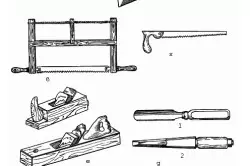
Tools for the manufacture of sliding table.
- drill;
- screwdriver;
- Bulgarian;
- hacksaw;
- screwdriver;
- a hammer;
- chisel;
- plane;
- emery skin;
- file;
- painting brush;
- line;
- roulette;
- calipers;
- scissors;
- electrolovik;
- grinders.
The sliding table is a very convenient and practical element of furniture. It will help solve some problems associated with a shortage area.
This table can be made with your own hands, if you make a little fantasy and get acquainted with the basic principles of the process.
